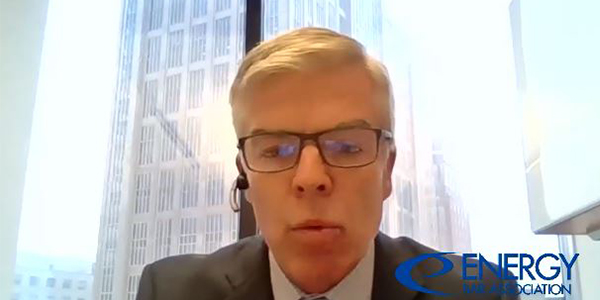The U.S. energy industry is still wrestling with the economic and social impacts of the COVID-19 pandemic that gripped the world nearly nine months ago, experts said Tuesday.
Managing the magnitude of the pandemic was the first discussion at the Energy Bar Association’s 2020 Fall Conference, held virtually Tuesday because of the pandemic. The discussion covered load impacts and economic consequences for utilities, regulatory responses, consumer-side adjustments and fuel and supply chain price changes.
Panelists included John O’Brien, executive vice president for strategy and public affairs at Washington Gas, and David DesLauriers, vice president at Charles River Associates.
Frank Graves, a principal with The Brattle Group, said the COVID-19 burden has been “uneven” across the energy industry, with different utilities and sectors experiencing contrasting impacts.
Utility companies have weathered most of the economic impacts of COVID-19, Graves said, while some businesses in the energy sector, such as small oil and gas development companies, have experienced bankruptcy. He said utility stocks have trailed the S&P 500, remaining relatively sluggish throughout the summer versus the S&P 500’s overall growth of 10%.
“Even though we’ve improved a lot, we still aren’t very close to where we would like to be,” Graves said.
The U.S. Energy Information Administration forecasts that 2020 electricity consumption will drop by 2.2% relative to 2019 based on a 3.2% increase in residential sales, a 6.2% drop in commercial sales and a 5.6% drop in industrial sales.
Daily LMPs have been below past two-year averages by 10-70% in almost every month since February in every ISO/RTO, Graves said. The drop in LMPs is not solely due to COVID-19 consumption changes, he said, with lower natural gas costs — partially the result of the pandemic — likely playing a bigger role.
But the drop in LMPs will strain the viability for some coal and nuclear plants, Graves said. ERCOT prices were down 64% in September compared to the two-year historical average, while PJM and NYISO have seen declines of 33% and 32%, respectively, in the same period.
Graves highlighted the impact on regional electric loads, which declined by 7% in September compared with the previous four years, despite a return to relatively normal in mid-summer. The September decline was in line with the April (6.5%) and May (7.5%) declines at the height of the pandemic.
PJM and MISO accounted for most of the September decrease, with states in their footprints seeing among the largest surges in COVID-19 cases since mid-summer, Graves said. Warmer than normal temperatures in those regions also contributed to the decline, along with colleges and universities that have not reopened campuses.
“We haven’t been able to unpack this very much, but that’s a surprise that there’s a big drop in September when we’ve had some economic rebound over the last few months,” Graves said.
‘Devastating’
Sandra Mattavous-Frye of the D.C. Office of the People’s Counsel said the pandemic has been “the single most devastating event to impact our country” in more than a century and no sector, population or industry has gone unscathed, including the energy industry.
Mattavous-Frye said the unique nature of the pandemic provides challenges for the energy industry but affordable, safe and reliable utility service, along with strong consumer protections, remains her guiding principle as a consumer advocate.
She said three principles must be in place when dealing with the fallout from COVID-19.
First, there must be equitable cost sharing. While the financial stability of utilities must be ensured, it can’t be “business as usual” where ratepayers are expected to bear the entire cost — utilities must also carry a fair share, she said.
Second, public officials must implement enhanced and sustainable permanent consumer protections for underserved and low- to moderate-income households. Those protections must offer a comprehensive approach to service disconnections, including reasonable payment and billing plans.
Finally, industry participants should identify the short- and long-term negative impacts of the pandemic on all segments of the energy industry. She said forums like Tuesday’s event are a good start.
“I really believe it is an obligation to step outside of the box of our traditional regulatory roles with a shared commitment to overcome the challenges we are facing and explore viable options to address the problem head on,” Mattavous-Frye said.



